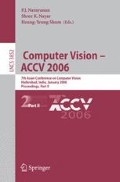Abstract
We describe a method for computing a dense estimate of motion and disparity, given a stereo video sequence containing moving non-rigid objects. In contrast to previous approaches, motion and disparity are estimated simultaneously from a single coherent probabilistic model that correctly accounts for all occlusions, depth discontinuities, and motion discontinuities. The results demonstrate that simultaneous estimation of motion and disparity is superior to estimating either in isolation, and show the promise of the technique for accurate, probabilistically justified, scene analysis.
Access this chapter
Tax calculation will be finalised at checkout
Purchases are for personal use only
Preview
Unable to display preview. Download preview PDF.
References
Waxman, A., Duncan, J.: Binocular image flows: Steps towards stereo-motion fusion. IEEE Trans. on PAMI 8, 715–729 (1986)
Williams, O., Isard, M., MacCormick, J.: Estimating disparity and occlusions in stereo video sequences. In: Proc. CVPR (2005)
Chang, Y., Aggarwal, J.: Line correspondences from cooperating spatial and temporal grouping processes for a sequence of images. Computer Vision and Image Understanding 67, 186–201 (1997)
Ho, A., Pong, T.: Cooperative fusion of stereo and motion. Pattern Recognition 29, 121–130 (1996)
Wang, W., Duncan, J.: Recovering the three dimensional motion and structure of multiple moving objects from binocular image flows. Computer Vision and Image Understanding 63, 430–446 (1996)
Sun, J., Shum, H.Y., Zheng, N.N.: Stereo matching using belief propagation. In: Heyden, A., Sparr, G., Nielsen, M., Johansen, P. (eds.) ECCV 2002. LNCS, vol. 2351, pp. 510–524. Springer, Heidelberg (2002)
Kolmogorov, V., Zabih, R.: Computing visual correspondence with occlusions using graph cuts. In: Proc. Int. Conf. on Computer Vision (2001)
Criminisi, A., Shotton, J., Blake, A., Torr, P.: Gaze manipulation for one-to-one teleconferencing. In: Proc. Int. Conf. on Computer Vision (2003)
Leung, C., Appleton, B., Lovell, B.C., Sun, C.: An energy minimisation approach to stereo-temporal dense reconstruction. In: Proc. Int. Conf. on Pattern Recognition (2004)
Zhang, L., Curless, B., Seitz, S.M.: Spacetime stereo: Shape recovery for dynamic scenes. In: Proc. CVPR., vol. 2, pp. 367–374 (2003)
Shao, J.: Generation of temporally consistent multiple virtual camera views from stereoscopic image sequences. Int. J. Comput. Vision 47, 171–180 (2002)
Vedula, S., Baker, S., Rander, P., Collins, R., Kanade, T.: Three-dimensional scene flow. In: Proc. Int. Conf. on Computer Vision, vol. 2, pp. 722–729 (1999)
Belhumeur, P.: A Bayesian approach to binocular stereopsis. Int. J. Computer Vision 19, 237–260 (1996)
Scharstein, D., Szeliski, R.: A taxonomy and evaluation of dense two-frame stereo correspondence algorithms. Int. J. Computer Vision (2002)
Baker, S., Matthews, I.: Lucas-Kanade 20 years on: A unifying framework. Int. J. Comput. Vision 56, 221–255 (2004)
Isard, M., MacCormick, J.: Dense motion and disparity estimation via loopy belief propagation. Technical report, Microsoft Research (2005)
Blake, A., et al.: Bi-layer segmentation of binocular stereo video. In: Proc. CVPR (2005)
Yedidia, J., Freeman, W., Weiss, Y.: Understanding Belief Propagation and its Generalizations. In: Exploring Artificial Intelligence in the New Millennium, Elsevier Science, Amsterdam (2003)
Felzenszwalb, P., Huttenlocher, D.: Efficient belief propagation for early vision. In: Proc. CVPR (2004)
Author information
Authors and Affiliations
Editor information
Editors and Affiliations
Rights and permissions
Copyright information
© 2006 Springer-Verlag Berlin Heidelberg
About this paper
Cite this paper
Isard, M., MacCormick, J. (2006). Dense Motion and Disparity Estimation Via Loopy Belief Propagation. In: Narayanan, P.J., Nayar, S.K., Shum, HY. (eds) Computer Vision – ACCV 2006. ACCV 2006. Lecture Notes in Computer Science, vol 3852. Springer, Berlin, Heidelberg. https://doi.org/10.1007/11612704_4
Download citation
DOI: https://doi.org/10.1007/11612704_4
Publisher Name: Springer, Berlin, Heidelberg
Print ISBN: 978-3-540-31244-4
Online ISBN: 978-3-540-32432-4
eBook Packages: Computer ScienceComputer Science (R0)

